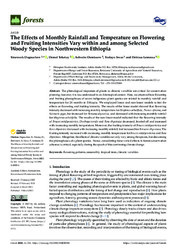The Effects of Monthly Rainfall and Temperature on Flowering and Fruiting Intensities Vary within and among Selected Woody Species in Northwestern Ethiopia. Forests.
Date
2023-03-10Author
Dagnachew, Sinework
Teketay, Demel
Demissew, Sebsebe
Awas, Tesfaye
Lemessa, Debissa
Metadata
Show full item recordAbstract
The phenological responses of plants to climatic variables are critical for conservation planning; however, it is less understood in an Afrotropical context. Here, we observed how flowering and fruiting phenophases of seven indigenous plant species are related to monthly rainfall and temperature for 24 months in Ethiopia. We employed linear and non-linear models to test the effects on flowering and fruiting intensity. The results of the linear model showed that flowering intensity decreased with increasing monthly temperature for Maytenus arbutifolia, Prunus africana, and Solanecio gigas, but increased for Bersama abyssinica, and decreased with increasing monthly rainfall for Maytenus arbutifolia. The results of the non-linear model indicated that the flowering intensity of Brucea antidysenterica, Dombeya torrida and Rosa abyssinica decreased, leveled off and increased with increasing monthly temperature. Moreover, the fruiting intensity of Brucea antidysenterica and Rosa abyssinica decreased with increasing monthly rainfall, but increased for Bersama abyssinica; The fruiting intensity increased with increasing monthly temperature for Brucea antidysenterica and Rosa abyssinica. Altogether, the effects of climatic variables not only vary among the species, but also among the phenophases of a plant species. Hence, considering these varied effects in forest conservation schemes is critical, especially during the epoch of this continuing climate change.
URI
https://www.mdpi.com/journal/forestshttps://doaj.org/toc/1999-4907
https://doi.org/10.3390/f14030541
https://hdl.handle.net/13049/668
Collections
- Research articles [88]

